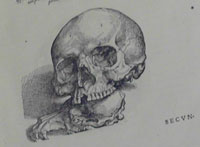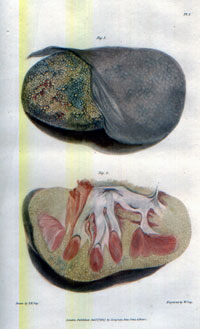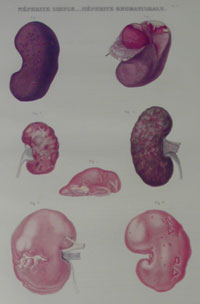By: Ron Sims, Special Collections Librarian
Dr. Meryl H. Haber, Northwestern University, BS ’56, MS ’58, MD ‘59, GME ’64 has presented the Galter Health Sciences Library with seven rare and valuable titles from his private collection. On Wednesday, October 21, 2010, a small reception for Dr. and Mrs. Haber was held in Dollie’s Corner to celebrate and thank them for their generous gifts.
In addition to the donated rare volumes, Dr. and Mrs. Haber have graciously provided funds for use in the conservation and restoration of books and materials already held by the Library’s Special Collections. Dr. Haber has a long standing interest in book-binding and restoration and has studied at Chicago’s Newberry Library conservation laboratory.
The Books
The volumes, published between 1506 and 1860, represent seminal works in anatomy and pathology and are wonderful additions to the rare book collections.
Ulrich Pinder’s Epiphanie medicorum, Speculum videndi urinas hominum, Clavis aperiendi portas pulsuum, Berillus discernendi causas & differentias febrium was published in Nuremberg in 1506 and contains 205 leaves (410 pages) with woodcut illustrations throughout. This is one of the earliest books printed from a physician's private press, which was set up in Pinder's home in Nuremberg where he was city physician. The three Epiphaniae treat the colors of urine and their significance; movement of the heart and pulse; and the various fevers and feverish states caused by emotions and diseases. This work also includes Gilles de Corbeil's Carmina de urinarum judiciis.
 De humani corporis fabrica libri septem by Andreas Vesalius was published in Basel in 1555 and contains 824 pages, 27 leaves of woodcuts and a portrait of the author. This text marked the beginning of a revolutionary moment in anatomy and surgery, presenting anatomical information in a format surpassed by no other scientific treatise. At the age of 28 years, Vesalius derived accurate information of the body's structure and the function of its parts from actual dissections. The Fabrica, one of the most beautifully printed works of its time, is remarkable for its series of magnificent plates which set new technical standards of anatomical illustration and, indeed, of book illustration in general.
De humani corporis fabrica libri septem by Andreas Vesalius was published in Basel in 1555 and contains 824 pages, 27 leaves of woodcuts and a portrait of the author. This text marked the beginning of a revolutionary moment in anatomy and surgery, presenting anatomical information in a format surpassed by no other scientific treatise. At the age of 28 years, Vesalius derived accurate information of the body's structure and the function of its parts from actual dissections. The Fabrica, one of the most beautifully printed works of its time, is remarkable for its series of magnificent plates which set new technical standards of anatomical illustration and, indeed, of book illustration in general.
 Richard Bright’s Reports of medical cases (volume 1) was published in London in 1827. It contains 222 pages and 16 plates, some of which are in color and folded. Bright was the leading medical consultant in London at the time and one of the most famous of the "great men of Guy's" Hospital. A student of Sir Astley Cooper and James Currie, Bright's powers of observation marked him as a true follower of Thomas Sydenham.
Richard Bright’s Reports of medical cases (volume 1) was published in London in 1827. It contains 222 pages and 16 plates, some of which are in color and folded. Bright was the leading medical consultant in London at the time and one of the most famous of the "great men of Guy's" Hospital. A student of Sir Astley Cooper and James Currie, Bright's powers of observation marked him as a true follower of Thomas Sydenham.
Although Bright advanced no new theories of disease and did little original classification in pathology, he collected and recorded an extraordinary amount of data from which he was able to draw his conclusions and base his assumptions. His Report of medical cases covers a large number of diseases and is one of the most important books in nineteenth-century medical literature. The detailed case reports are models of clarity and conciseness and give ample evidence of Bright's skill as a clinician. The sixteen color lithograph plates are among the finest medical illustrations created and are beautifully preserved in this copy. Special Collections holds volume 2 which was published in two parts in 1831. The Habers gift completes the set.
Jean Cruveilhier received his medical degree from Paris in 1816 and entered private practice at Limoges. In 1823 he was appointed professor of surgery at Montpellier. He accepted a professorship in pathological anatomy in 1836 established by an endowment left by Dupuytren. Cruveilhier’s Anatomie pathologique du corps humain (Paris, 1829-1842) presents a very comprehensive discussion of all aspects of pathological anatomy.
Unquestionably the greatest work of its kind ever published, the two volume set of oversized folio volumes, weighing nearly forty pounds, contains 240 plates, many in color and all accompanied by copious text. Published over a period of seven years, the set was issued in forty separate parts. The color lithographs were executed by Antoine Chazal and are some of the finest illustrations of gross pathology.
 Pierre Francois Olive Rayer’s Traité des maladies des reins et des altérations de la sécrétion urinaire, étudiées en elles-mêmes et dans leurs rapports avec les maladies des uretères, de la vessie, de la prostate, de l’urèthre, etc. was published in Paris between 1837 and 1841. His most important publication, Traité, is a three-volume treatise on diseases of the kidney with a spectacular oversized color-plate atlas marking a juncture in the development of the subject.
Pierre Francois Olive Rayer’s Traité des maladies des reins et des altérations de la sécrétion urinaire, étudiées en elles-mêmes et dans leurs rapports avec les maladies des uretères, de la vessie, de la prostate, de l’urèthre, etc. was published in Paris between 1837 and 1841. His most important publication, Traité, is a three-volume treatise on diseases of the kidney with a spectacular oversized color-plate atlas marking a juncture in the development of the subject.
Rayer began his medical studies at the School of Medicine in Caen, and then went to Paris to continue his education at the École pratique, the Hôtel-Dieu and the Maison royale de santé. He was nominated interne of the hospitals in 1813, and in 1818 obtained his doctorate with a thesis on the history of pathological anatomy. An outstanding diagnostician, Rayer’s research comprised pathological anatomy and physiology, special pathology, therapy, epidemiology, parasitology, comparative pathology and natural history.
One of London’s most respected physicians at Guy's Hospital, Thomas Addison, a brilliant lecturer and diagnostician, was entirely devoted to his students and patients. His 1855 monograph On the constitutional and local effects of disease of the supra-renal capsules (London) with 43 pages and 11 color plates is one of the truly remarkable medical books of the nineteenth century. Private collectors consider it to be among principal desiderata.
Two chronic diseases of the adrenal gland are described for the first time: Addison's disease and pernicious anemia (Addison's anemia). The work includes eleven excellent hand-colored lithographs. Although Addison's discoveries were never widely recognized during his lifetime, both are regarded as fundamentally significant in the study of the endocrine glands and the treatment of pluriglandular diseases.
Charles Darwin’s On the origin of species needs no introduction. Battle lines were drawn on both religious and scientific fronts when it was first published. World-wide criticism and controversy continues into the 21st century. Darwin's book was an instant success in England and the first run of 1,250 copies was sold out on the day of publication, November 24, 1859. A second edition of 3,000 copies was published just six weeks later on January 7, 1860. Dr. and Mrs. Haber’s gift volume is designated 'Fifth Thousand' on the title page indicating the second printing or better known as the 2nd edition of this seminal work. The introduction was completely reset with corrections, including the typographical error ‘speceies’ found in the 1859 edition.
Through the generosity of Dr. and Mrs. Haber, these items are available for study and viewing. Please call (312) 503-8133 or email for an appointment with the Special Collections Librarian.
Updated: March 5, 2020